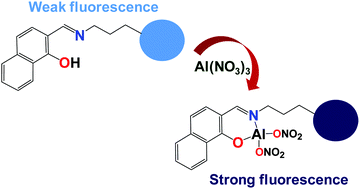2-Hydroxy-naphthyl functionalized mesoporous silica for fluorescence sensing and removal of aluminum ions†
Abstract
Mesoporous silica functionalized with a 2-hydroxy-naphthyl moiety has been synthesized and characterized by standard techniques like powder X-ray diffraction, N2 adsorption/desorption studies, transmission electron microscopy and spectral studies like FT-IR, UV-visible, fluorescence and 13C and 29Si solid state NMR. The functionalized silica material showed significant enhancement in its emission intensity in the presence of Al3+ ions whereas other metal ions could not bring about any increase in its emission intensity. They either quench the emission or do not alter the intensity significantly making the functionalized material a fluorescence chemosensor for Al3+. The sensitivity of the probe towards Al3+ has been determined to be high with a low limit of detection value. As functionalized silica is not soluble in common solvents, it has been effectively used to bind and remove Al3+ from a solution. Theoretical calculations on a model system have been performed to investigate the electronic spectral transitions.



 Please wait while we load your content...
Please wait while we load your content...